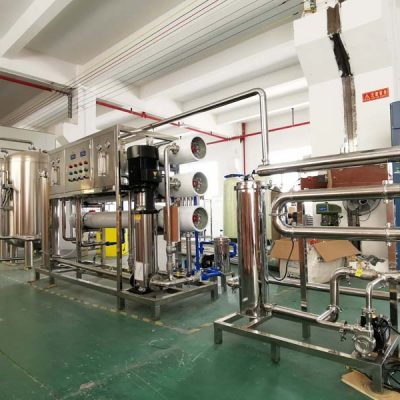RO water treatment system

Vietnam water bottling plants
October 19, 2019
Whether in China or around the world to build mineral water plant, we must pay attention to the following points
December 12, 2019
RO water treatment system is also known as reverse osmosis water treatment system, is a membrane separation technology developed in the sixties, the principle is that raw water under the action of high pressure through reverse osmosis membrane, the solvent in the water from low concentration to high concentration diffusion to achieve the purpose of separation, purification, concentration, because it is in the opposite direction of penetration in nature, It is called reverse osmosis. Reverse osmosis water treatment systems remove bacteria, viruses, colloids, organics and more than 98% of soluble salts from water. The method has the characteristics of low operating cost, simple operation, high degree of automation and stable water quality. Compared with other traditional water treatment methods, there are obvious advantages, widely used in water treatment-related industries.
RO (Reverse Osmosis) is a membrane process that uses the selectivity of the RO membrane, powered by static pressure differences on both sides of the membrane, to overcome the osmotic pressure of the solvent (usually water), allowing the solvent to pass through the ionic substance and separate the liquid mixture. There are 2 necessary conditions for THE RO separation process: first, the applied pressure must be greater than the permeation pressure of the solution (the operating pressure is generally 1.5 to 10.5MPa); THE MICROPOROUS APERTURE ON THE SURFACE OF THE RO MEMBRANE IS GENERALLY LESS THAN 1NM, AND HAS A HIGH REMOVAL RATE FOR MOST INORGANIC SALTS, SOLUBILITYED ORGANIC SAMULSIONS, SOLUBILITY SOLIDS, ORGANISMS AND COLLOIDS. The development of RO membrane has gone through three stages. At present, China's commonly used RO membrane materials are mainly acetate cellulose membrane (CA membrane), aromatic polyamide membrane (PA membrane) and shell polysaccharide membrane (CS membrane) these 3 categories. CA membrane is the earliest use of membrane materials, odorless, odorless, non-toxic, light stability, moisture absorption is strong, but CA film chemical stability, thermal stability, pressure tightness is poor, and easy to degrade. PA membrane is the most commonly used RO film in industry, with materialization stability, resistance to strong alkali, oil esters, organic solvents, good mechanical strength and other advantages, but PA membrane has the properties of charge, water particles are easy to deposit on the surface of the membrane, the formation of membrane pollution, shorten the service life. CS membrane is a natural polymer membrane material, non-toxic, non-side effects, can antibacterial, alkali soil metal ion removal ability, is a superior hard water softening RO membrane, is a very potential membrane material, received great attention in the international. Recent developments in RO membranes include inorganic membranes, hybrid membranes and new organic membranes. In theory, inorganic membrane ion interception performance is very high, but the cost is high, the preparation conditions are harsh, is not conducive to industrial application, hybrid film combines the advantages of organic materials and inorganic materials, in improving membrane separation performance and anti-pollution has a good application prospects, has great potential for development, need further theoretical research. The preparation of the new organic film is still in its infancy, the main purpose is to improve membrane flux and chemical stability, and no breakthrough has been made.Related posts
July 20, 2020
April 28, 2020




